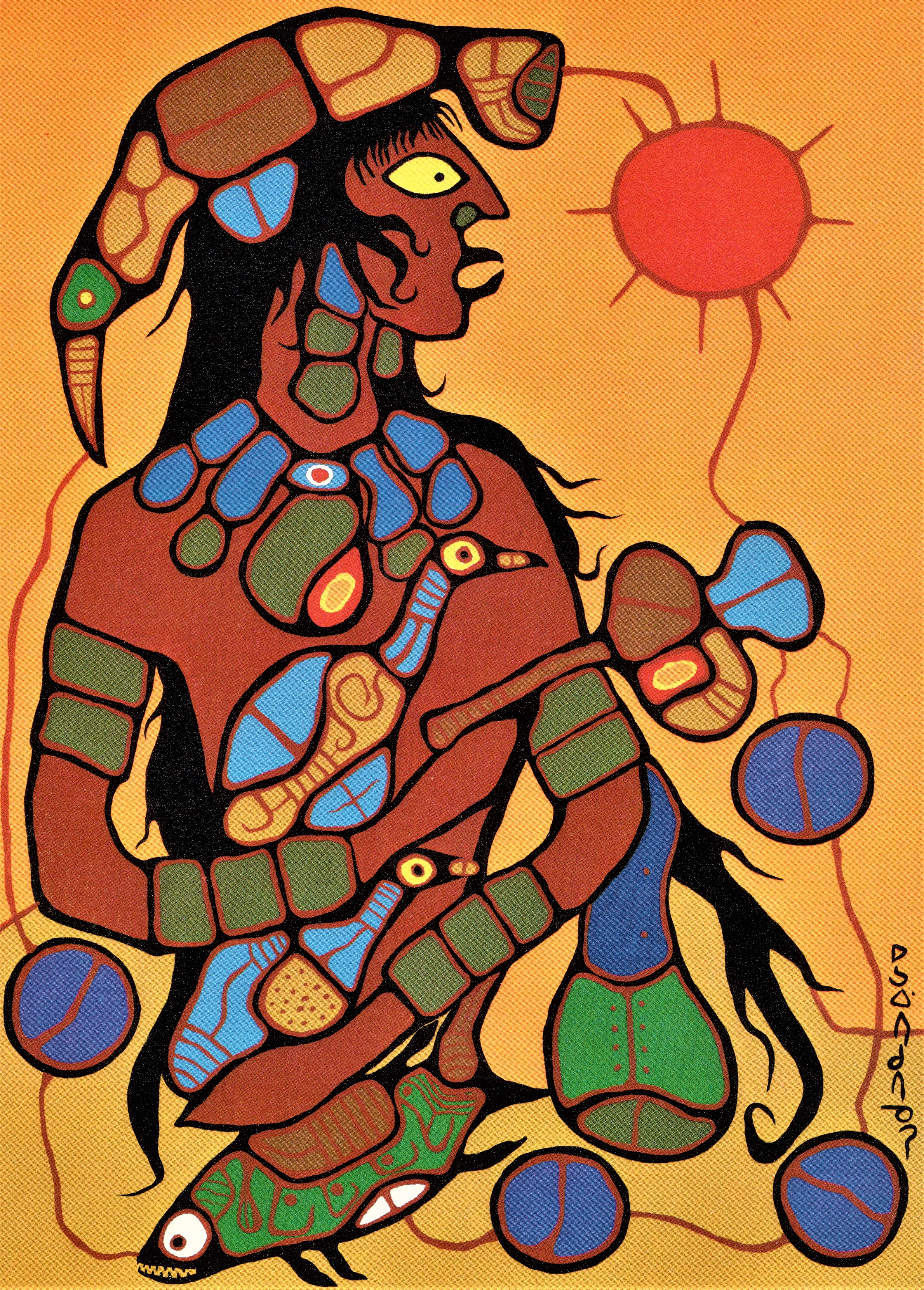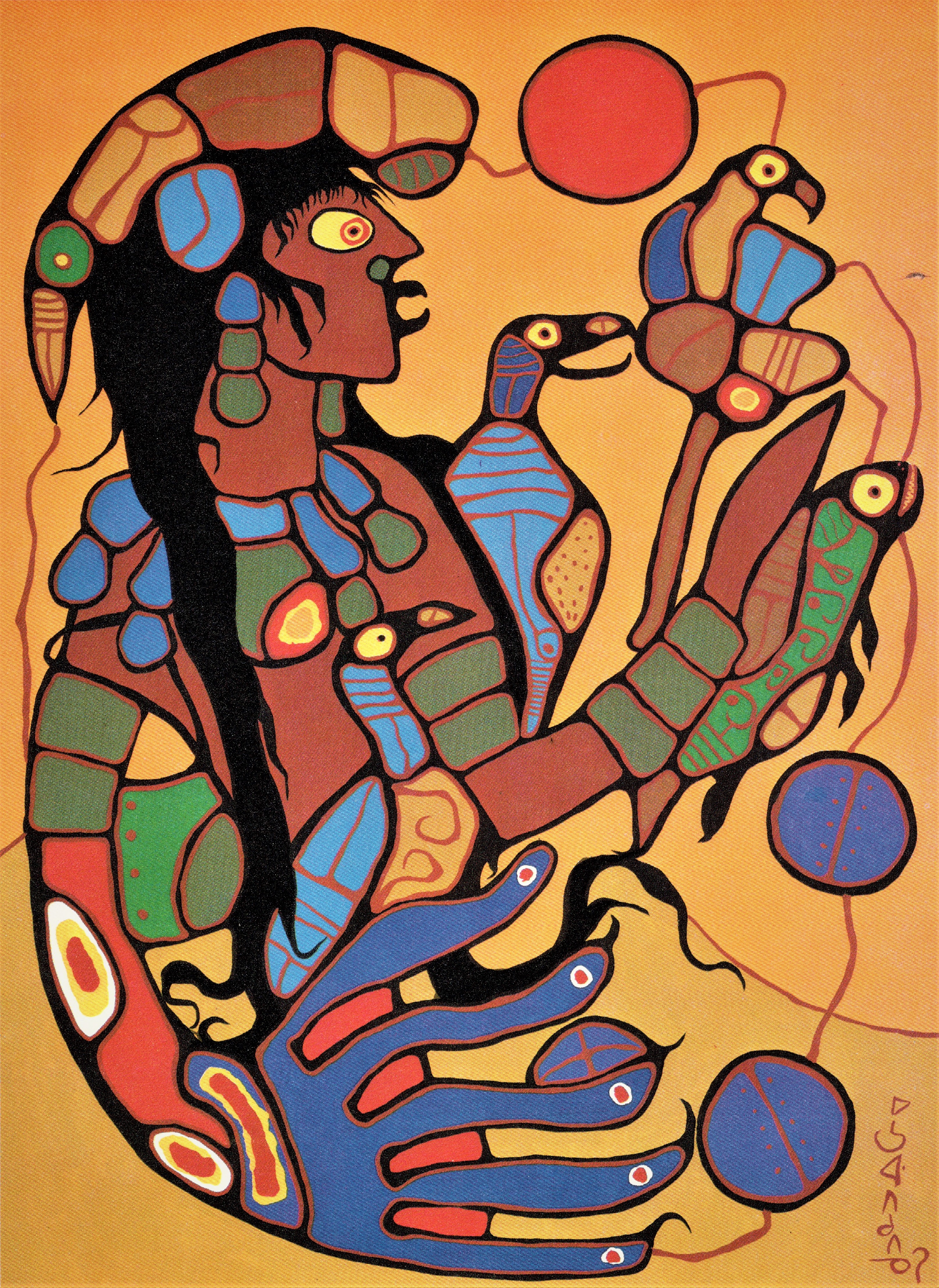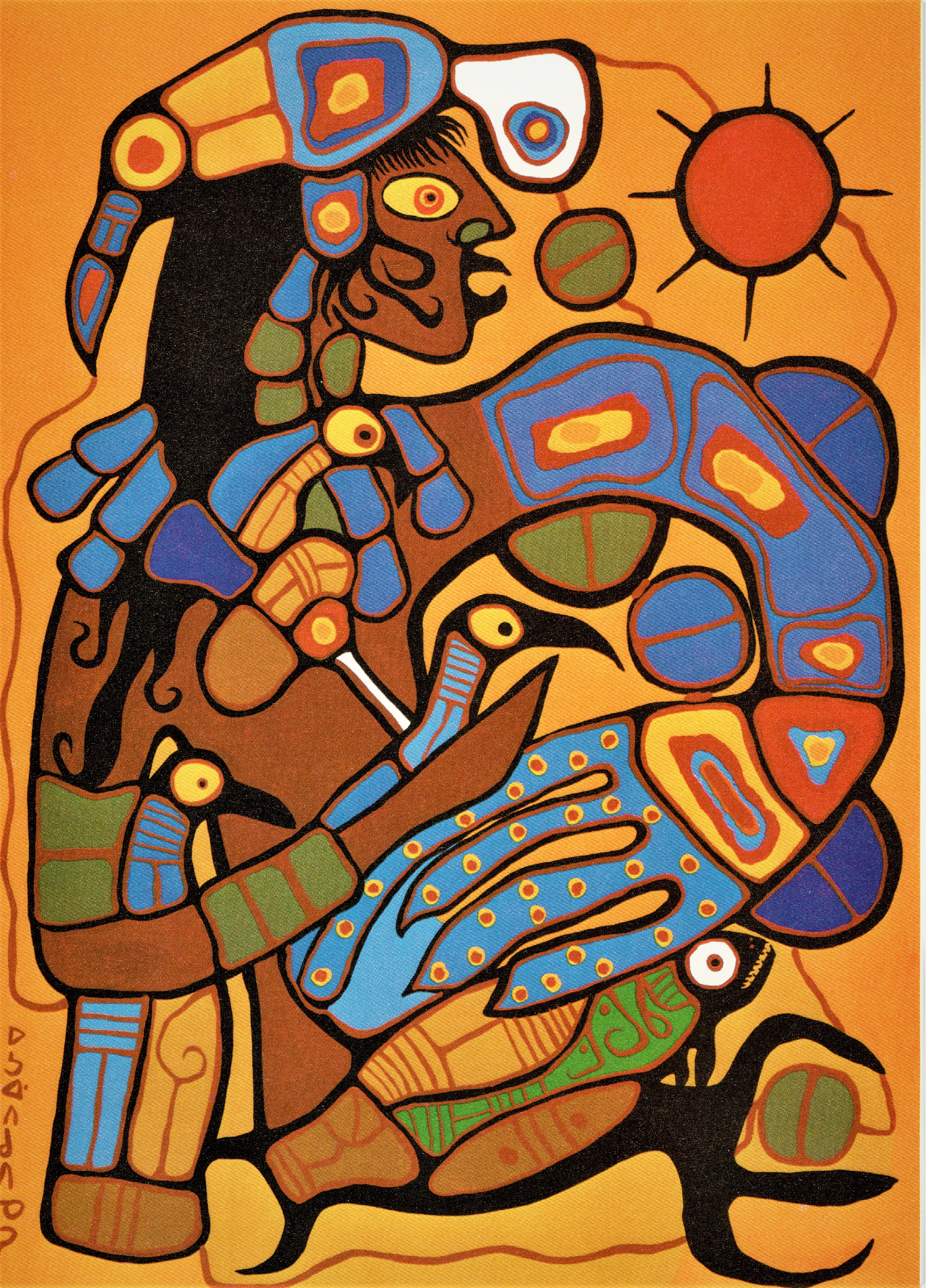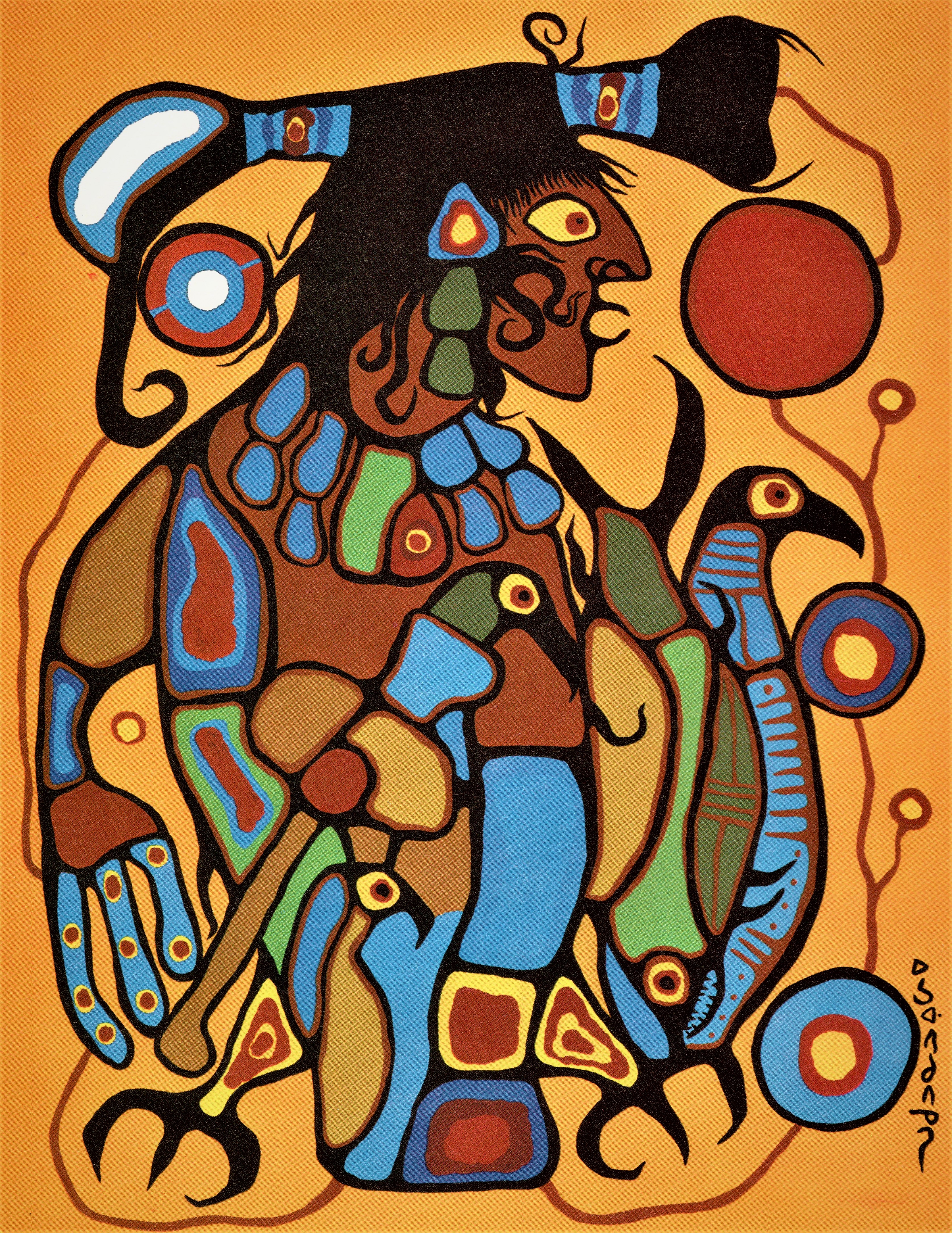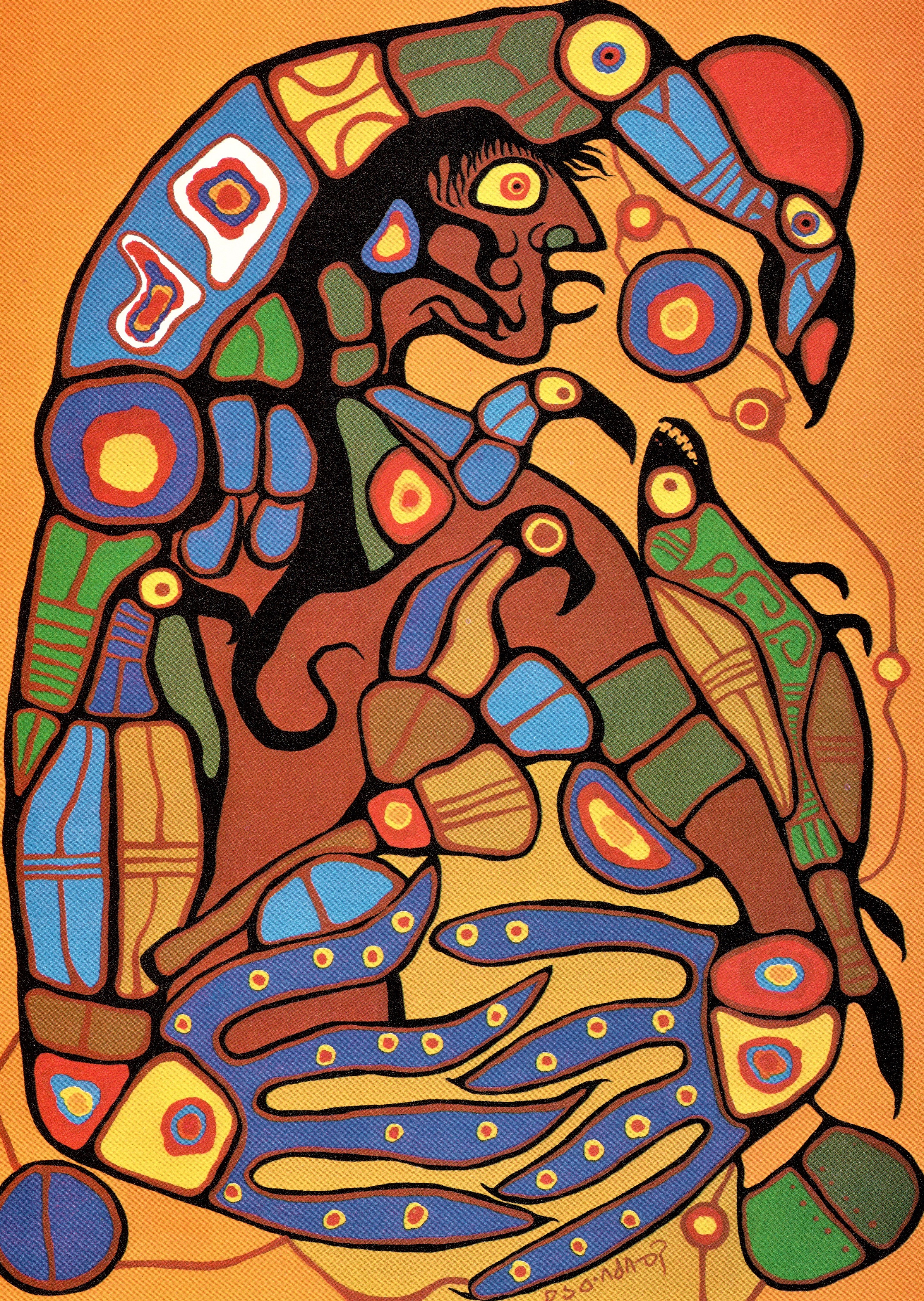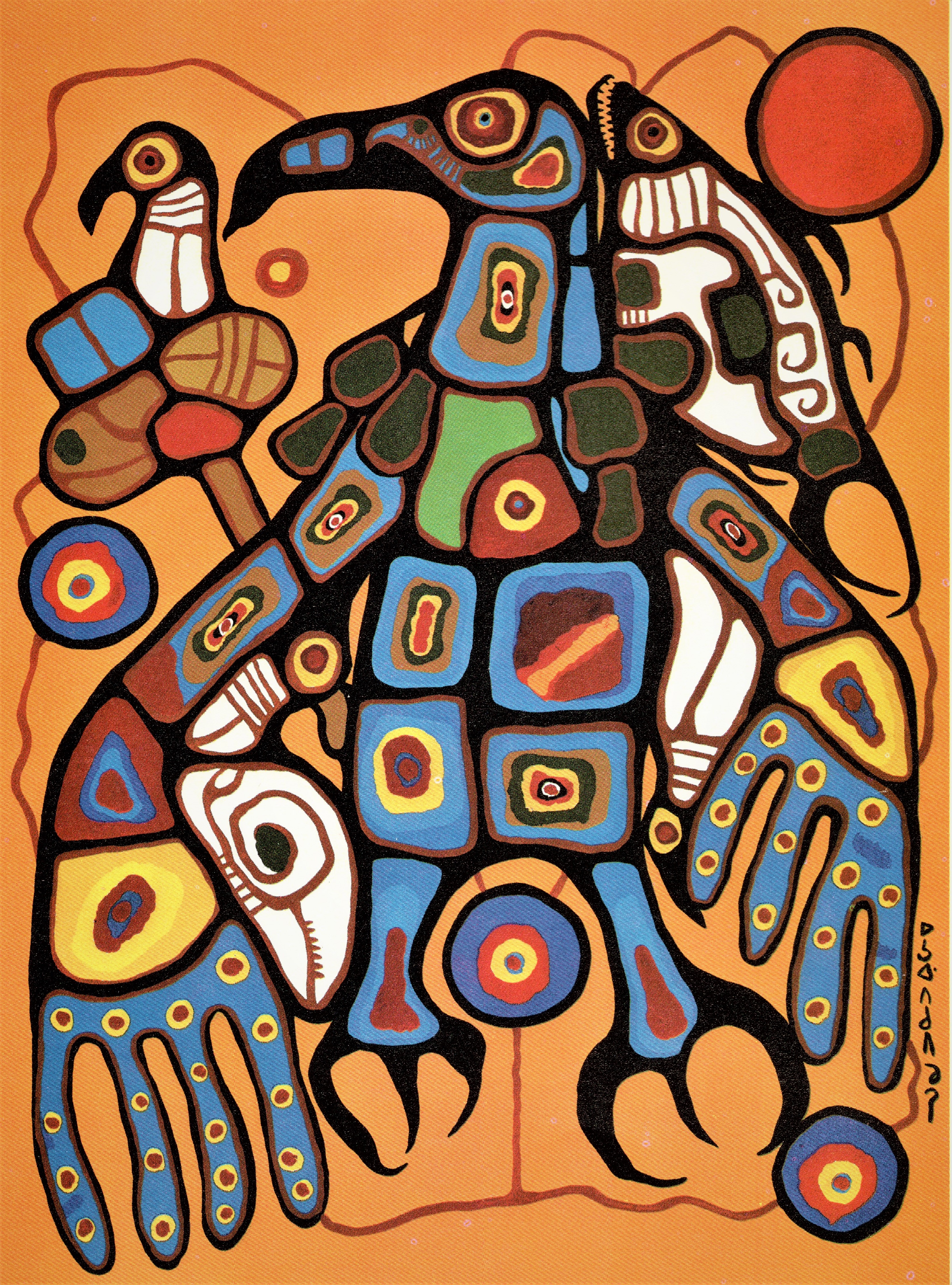Minds On
Let’s get started!
Exploring art
Explore the following artwork.
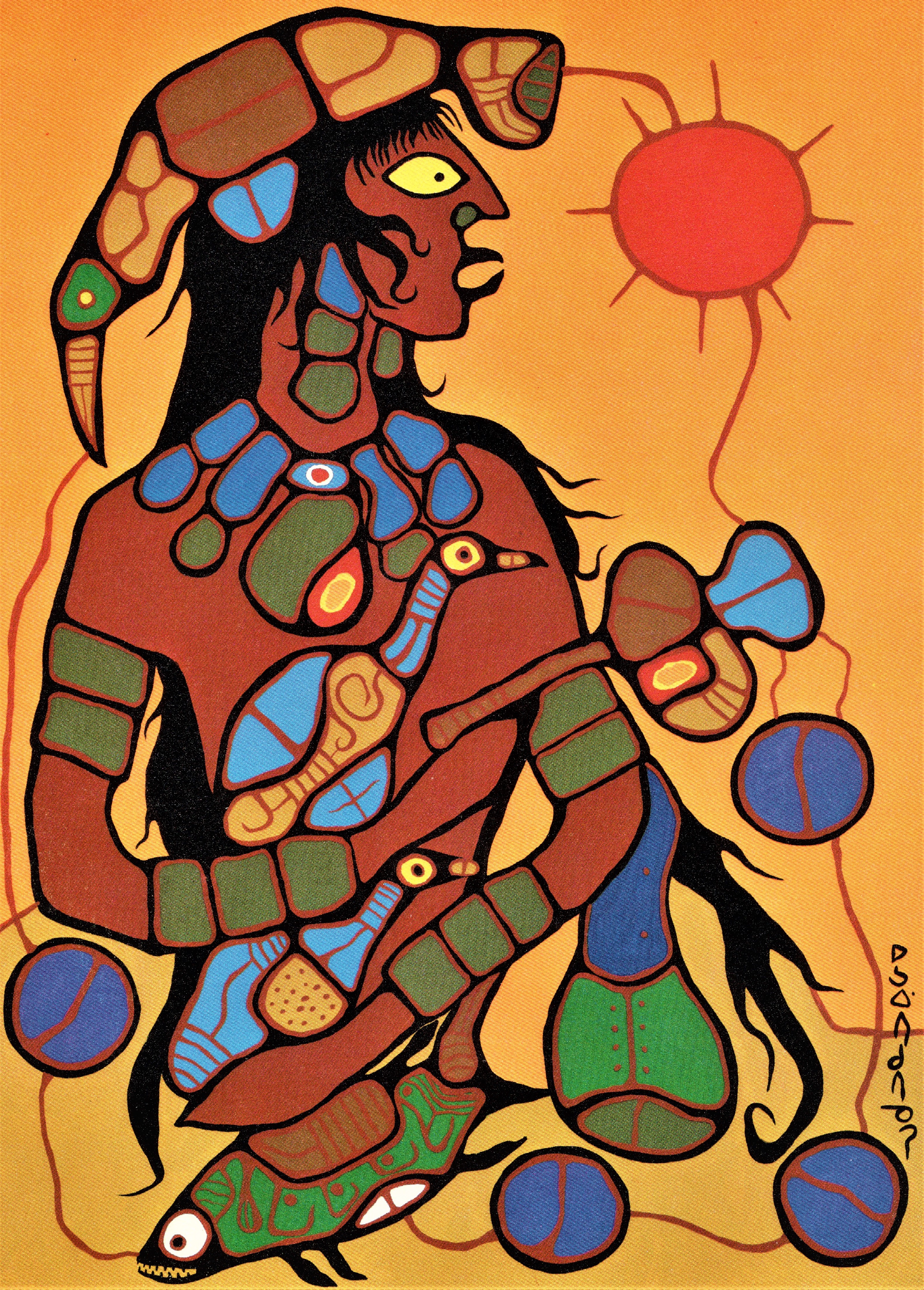
Man Changing into Thunderbird (Panel 1) by Norval Morrisseau, 1977
The upper body of a human figure decorated with cool-hued, organic rectangular shapes on their ears, neck, biceps, and wrists. They wear a headdress and have hair that is as long as their torso. They cradle a bird in each arm and there is a fish at their waist. There is a warm-hued circle in the upper-right corner that the figure is looking at. A thin, curving line encircles the figure and connects the circle, fish, and headdress.
- What elements of design were used to create this artwork?
- What do you notice about this artwork?
- What do you notice about the relationship between the animals, the sun, and the man?
- How does this artwork make you feel?
Record your responses using a method of your choice. If possible, share your thoughts with a partner.
Elements of design
The elements of design are the basic attributes, ideas, and parts that are used to create an artwork. The seven elements of design are line, shape, colour, value, form, texture, and space.
Press the following tabs to access definitions of each element of design.

Different types of lines. Horizontal lines go left to right. Vertical lines go up and down. Diagonal lines are straight lines drawn on an angle. Zigzag lines are comprised of straight line segments that take many sharp turns. A curved line is not straight and bends.
Lines are the paths left by a moving point, such as a pencil or a digital drawing tool. A line can be a mark, a guide, or a boundary that leads the audience's attention in an artwork. Diversity in the type, orientation, and/or quality of lines can be used to suggest a variety of ideas, shapes, or emotions. For example, horizontal and curving lines can feel restful or inactive. Vertical and diagonal lines can create the idea of movement or action. Horizontal and vertical lines can create stability.

Different types of shapes. Geometric shapes are closed figures with straight uniform lines and angles, like squares and triangles. Circles are also a geometric shape and the exception to the rule. Organic shapes are closed figures that don't follow any specific rules, often utilize curved lines, and mimic shapes found in nature. Finally, a positive shape is the space an object takes up while a negative shape is the area between objects.
A shape is a form that is enclosed or outlined. For example, when three lines meet, they create the shape of a triangle. A shape has length and width. A shape’s boundary can be created by line, value, colour, and/or texture. Shapes may be geometric or organic. Shapes may be positive or negative.

A colour wheel divided into 12 sections, with each section as a different colour. The top right quarter contains the primary colour yellow, the secondary colour orange, and the tertiary colour achieved by mixing yellow and orange. The bottom right quarter contains the primary colour red, the tertiary colour achieved by mixing red and orange, and the tertiary colour achieved by mixing red and purple. The bottom left quarter contains the primary colour blue, the secondary colour purple, and the tertiary colour achieved by mixing blue and purple. The top left quart contains the secondary colour green, the tertiary colour achieved by mixing green and blue, and the tertiary colour achieved by mixing green and yellow. The left half of the colour with the blue and green colours is labeled cool colours, and the right half with the yellow and red colours is labeled warm colours.
In scientific terms, colour is an attribute of an object when light bounces off it. The four characteristics of colour are hue, value, intensity, and temperature. Colour categories include primary, secondary, and tertiary. Colours can be warm or cool. Cool colours include blue, green, and purple. Warm colours include red, orange, and yellow.

Swatches of green, with the darkest shade of green at the top and descending to the lightest shade. Similar swatches of shades of purple and black are also displayed.
Value is the lightness or darkness in an artwork. Value is created by the gradual changes in the lightness or darkness of an artwork even when colour is absent. Changes in value can be created by adding white or black to a colour and/or by erasing or adding more art medium to an art piece. Value is used to create the illusion of texture and light in art.

Form is the shape and dimensions of an artwork, or objects within an artwork. Forms can be three-dimensional. Form can also mean creating the illusion of a two-dimensional object being three-dimensional. The illusion of form can be created by using shading. Forms can be geometric or organic.

Texture is the feeling and appearance of a surface. Texture can be smooth, rough, furry, or soft. Texture can be the illusion of texture or real texture.

A scenic drawing where the bushes drawn at the bottom of the page appear to be closest to the viewer and are labeled as the foreground. A lake and trees are drawn to appear behind the bushes and take up the majority of the page. They are labeled middle ground. A mountain range and sky is drawn at the top of the page and appears to be behind the trees and lake. The mountains and sky are labeled as background.
Space can be the area around, inside, or between parts of an artwork. Space can be a physical distance between objects. Space can also be an illusion of distance in a two-dimensional piece. The illusion of space can be created by a variety of techniques, including overlapping parts, a variety of sizes, changing value or colour, the use of detail, and perspective.
Action
Get ready, get set…
Woodland Art
The artwork from our Minds On activity is an example of Woodland Art by the artist Norval Morrisseau, who was the founder of this style.
Also referred to as medicine painting, Woodland Art is an Indigenous style of art that is influenced by creation stories and shares the relationships between animals, people, the environment, and creation.
Indigenous communities have their own creation stories that express their understanding of the universe and how the physical, spiritual, and human world came to be. Indigenous peoples have extremely diverse cultures, so their stories and art forms are different depending on the way each nation expresses its worldview.
Norval Morrisseau
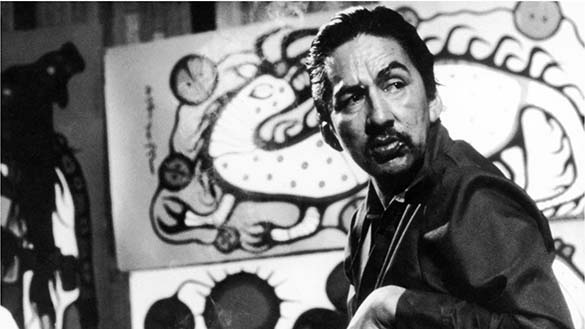
Norval Morrisseau in front of Water Spirit (from the documentary The Paradox of Norval Morrisseau, 1974)
Norval Morrisseau is an Ojibway artist from Bingwi Neyaashi Anishinaabek, a First Nations community near Lake Nipigon in Ontario, Canada. He was a self-taught artist who learned from his grandfather Moses Potan Nanakonagos (a Midewiwin shaman) about his culture and spiritual beliefs.
Morrisseau’s artwork reflects Anishinaabe worldviews and the teachings he learned throughout his life. He believed that Anishinaabe values needed to be shared to showcase the depth and beauty of Indigenous art and artforms. This was the beginning of the Woodland School of Art.
Common elements of Woodland Art
Some of the main concepts that are featured in Woodland Art include:
- creation stories and storytelling
- the relationship between human and animal life
- images of transformation between humans and animals
- being two beings at the same time (this is called the Thunderbird)
Press the following tabs to access descriptions of some common elements of design in Woodland Art.
- a circle split in half by a line across its centre
- a symbol that means two parts
- represents the duality of connection between worlds when connected with lines of communication
Explore the following painting Bear Cub. How many divided circles are included in the painting?
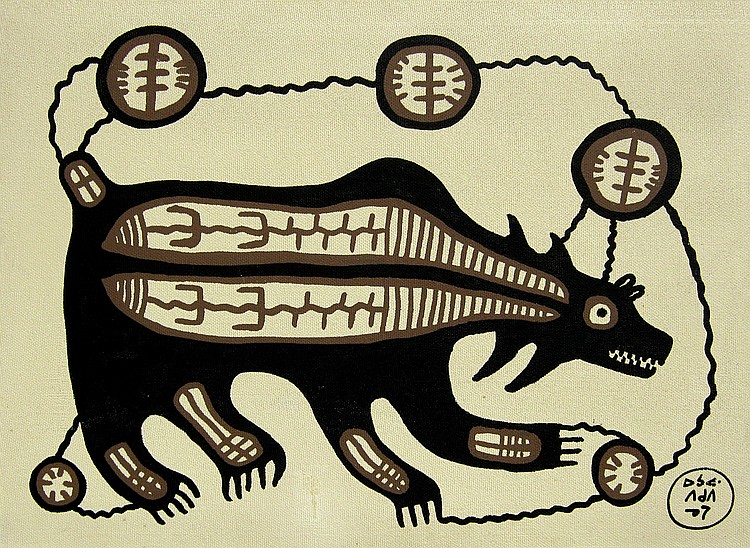
Bear Cub by Norval Morrisseau, 1962
A black bear cub is surrounded by divided circles. There is a line that connects the circles to each other. Additional lines connect circles to the head of the bear, the tail, the front paws and back paws.
- flowing lines that connect animals and humans
- a symbol that means connection
- it represents the interdependence between two beings and reflects the artist’s understanding of nature
Who is the mother loon communicating with?

Loon by Norval Morrisseau, 1967
This loon has a brown exterior with orange sections in its neck, belly and tail. It has two eggs that are resting under its chest area with lines of communication to its neck and body. There are also lines of power emanating from the loon’s body and lines of movement inside the loon.
- groups of very short lines around a subject or object
- a symbol that means movement
- it can represent something the artist is trying to communicate with the audience
Explore the following painting Soul Fish. Where has Morrisseau included lines of movement?
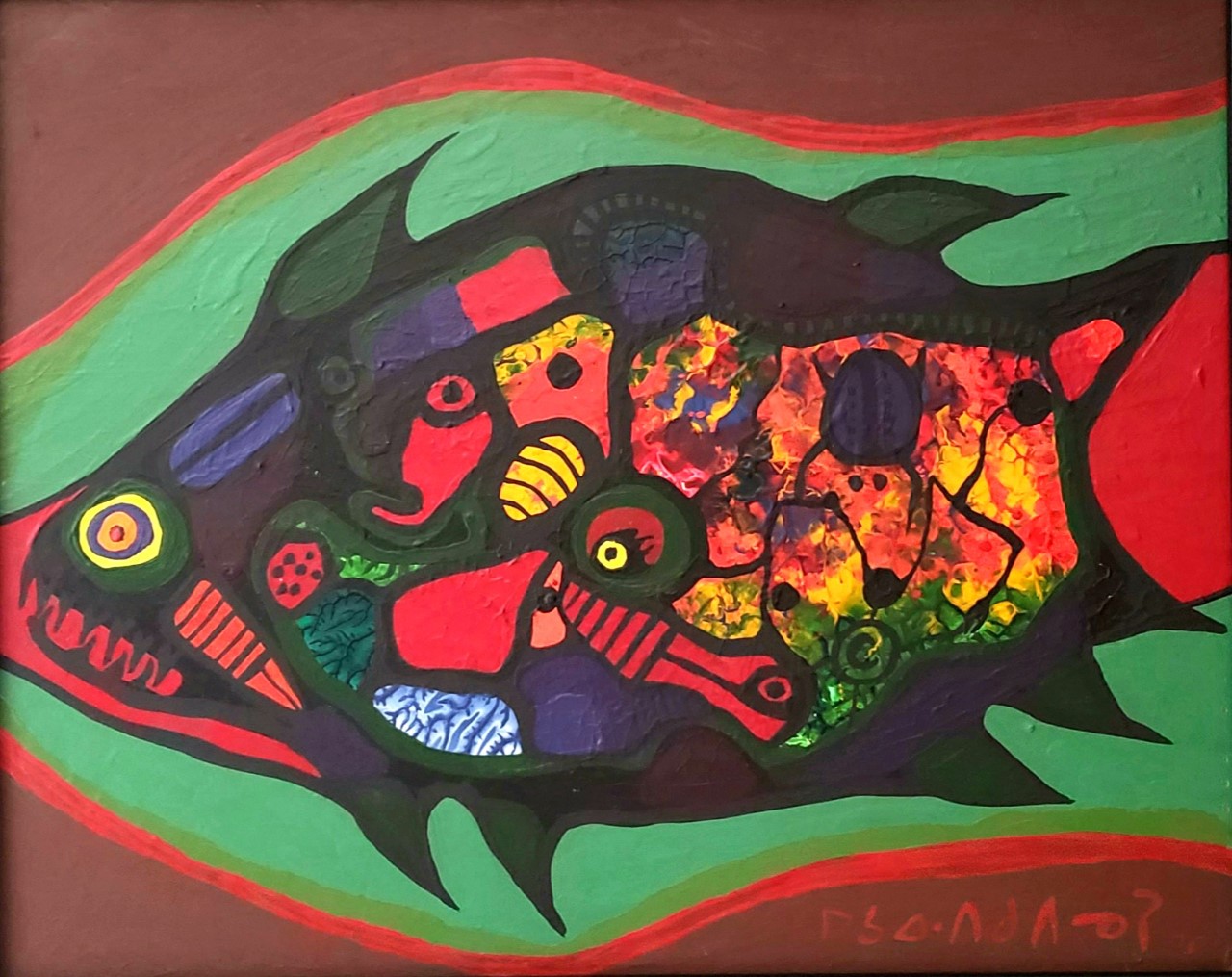
Soul Fish by Norval Morrisseau, 1970
This oil painting of a fish has a perimeter of green surrounded by a border of red. Inside the fish are many shapes in various colours including reds, yellows, purples, oranges, and greens. Within these shapes are lines of movement.
Soul Fish is one of only a few rare oil paintings that Norval Morrisseau created. Morrisseau was inspired by the old masters and decided to try using oil paint. The smell was so strong and took days to dry. During this time, he slept outdoors!
- lines coming from the heads and bodies of animals and people
- a symbol that means power (the length and colour of lines indicate the quality of power)
- it represents both sending and receiving information
Identify the lines of power in the painting Three Canoes.
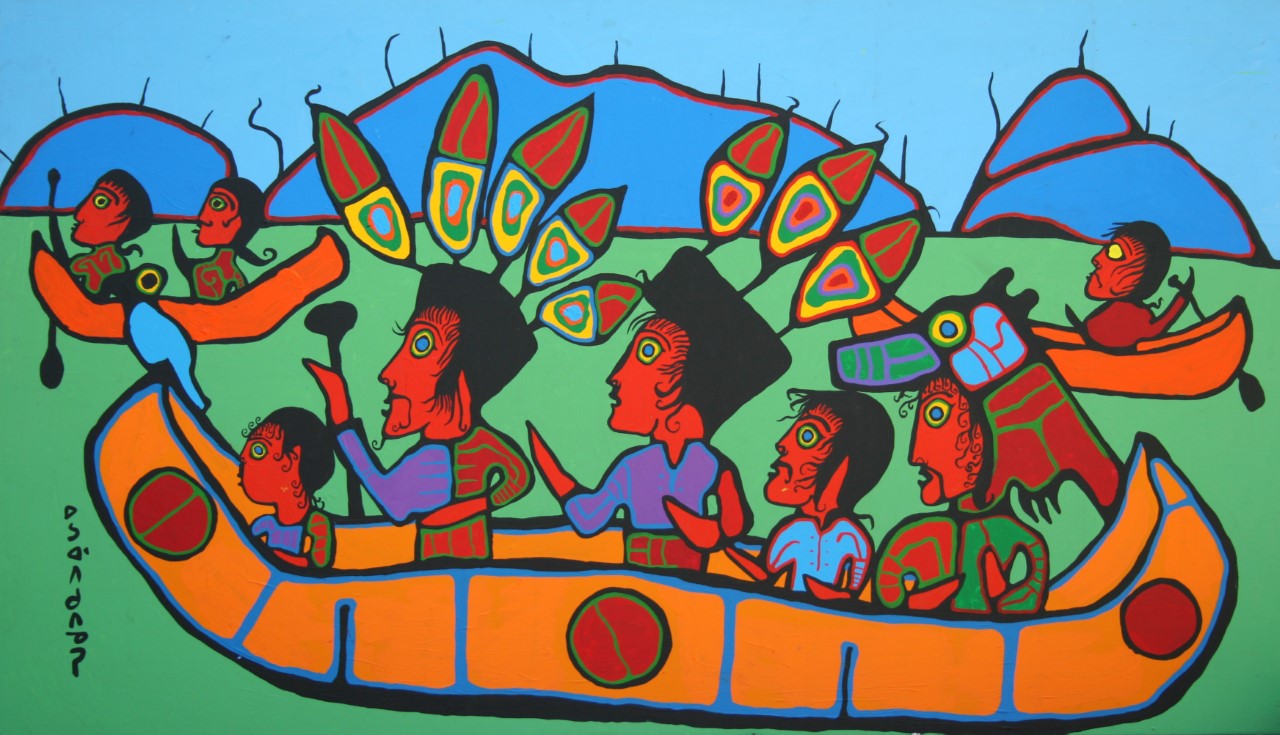
Three Canoes by Norval Morrisseau, 1991
People rowing three orange canoes. The water is coloured green and the hills in the background are blue. There are lines of power emanating from the hills. On the heads of two of the people in the largest canoe are feather shaped objects which are also emanating lines of power.
Norval Morrisseau believed that all life was interconnected. The energy of the land, animals and human beings are all important and equal. Without one we all suffer.
- curving lines coming from the mouth of a being
- a symbol that means prophecy
- it represents a vision or communicating with a spiritual force
What do you notice about the lines of prophecy in the painting Grandfather Teaching the Legends?
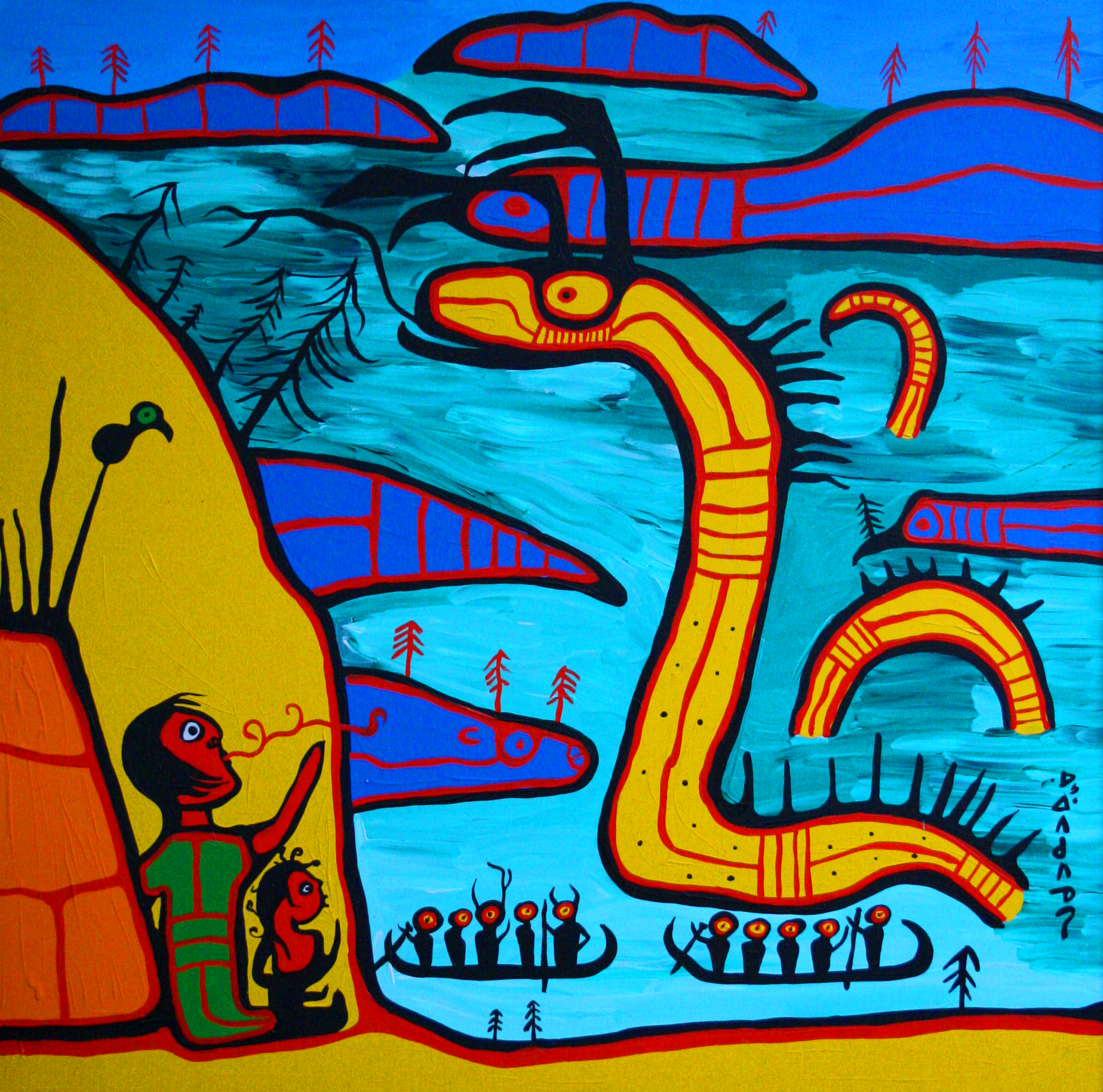
Grandfather Teaching the Legends by Norval Morrisseau, 1992
This image shows two human figures in front of a shelter by the water. In the water are two long boats with humans rowing and Grandfather snake. There are also islands in the water. There is a line that runs through the centre of the interior of Grandfather snake from its head to its tail. There are antler shaped objects on the top of its head and a line of prophecy that is emitting from its mouth. There are also lines of power emitting from the snake's body. There are black branch-like objects coming from the hill that is behind the shelter and a red line of power emitting from the mouth of the human who is facing the snake.
- the decorative shapes and colours represented inside of a being
- these symbols represent a being’s inner spiritual life
How has Carl Ray incorporated x-ray decoration into his painting Spirit Fish?
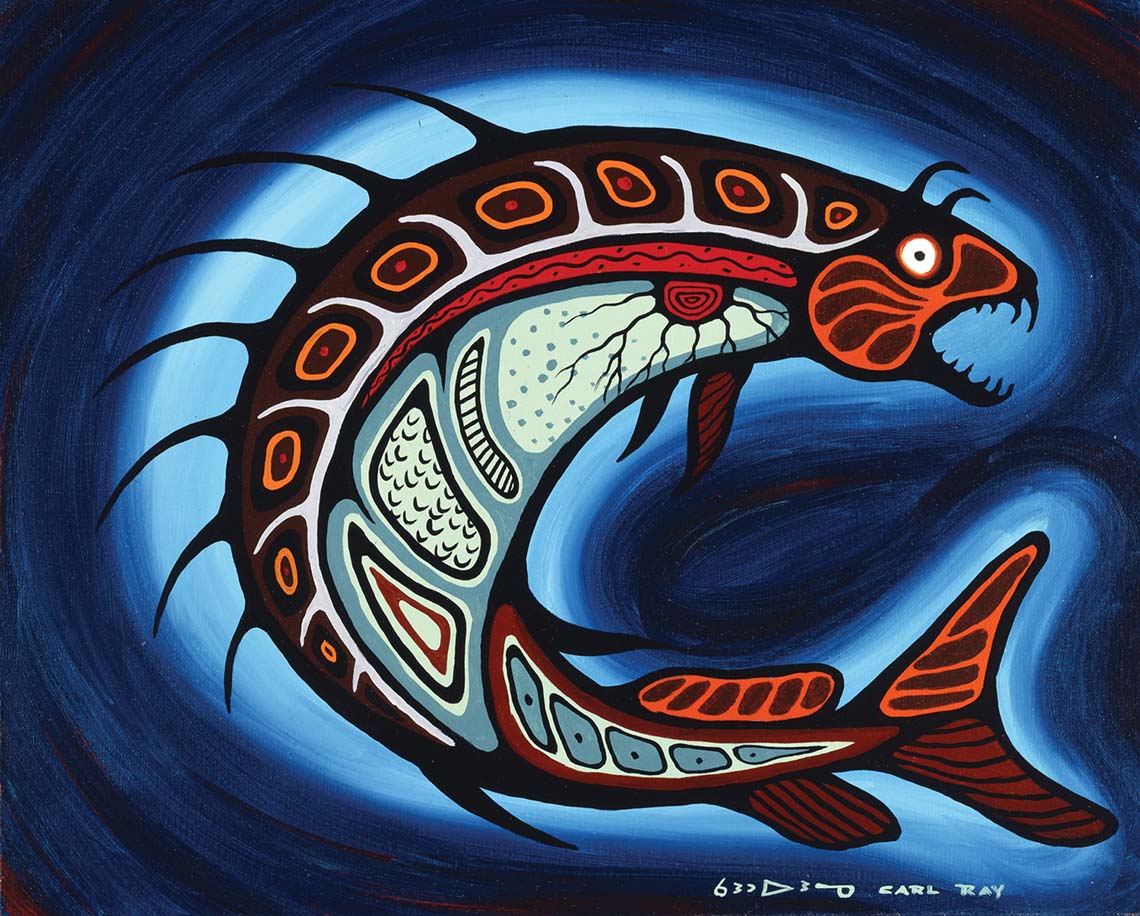
Carl Ray, Spirit Fish, c. 1975, McMichael Canadian Art Collection, 1975.32.2
- use of a reddish-brown pigment similar to the ochre used by prehistoric artists
- pure hues outlined with thick black borders (Norval Morrisseau used unmixed paints)
- colours can represent different things depending on the artist
How does the painting In Honor of Native Motherhood make you feel?
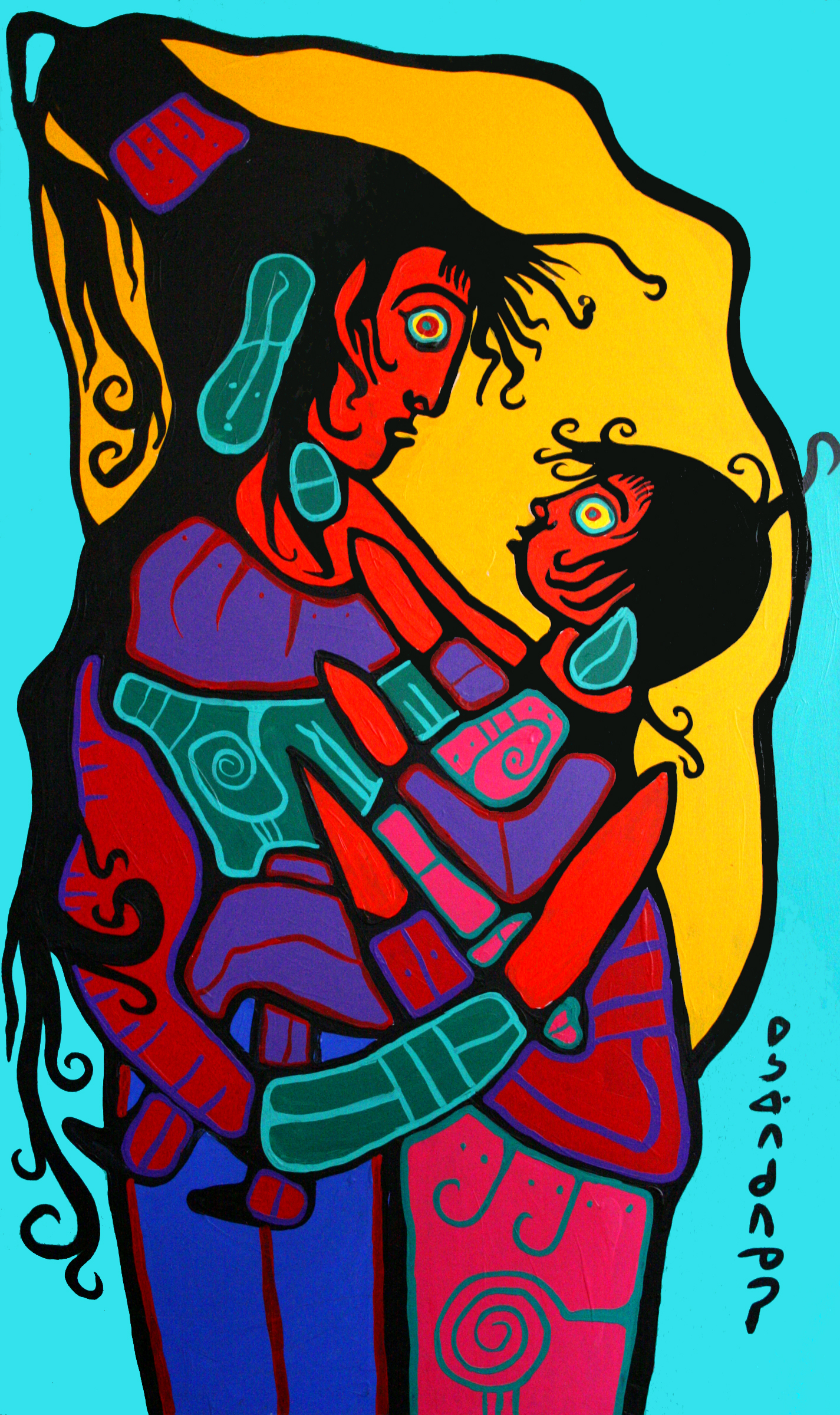
In Honor of Native Motherhood by Norval Morrisseau, 1992
This image of an adult and child has a blue background with an oval shape of yellow behind the figures. The figures are dressed in purples, pinks, reds and blues with green accessories such as earrings, sleeves and hair clips.
The colours used by Norval Morrisseau throughout his career have included vibrant, rich hues. After visiting the Louvre and seeing the dark museums of France Norval wanted his paintings to shine brightly when displayed.
Examining Woodland Art
Examine the following image of all six panels of the painting from our Minds On activity. You can click each image to enlarge them in a new window.
A carousel of six images depicting the six panels of Man Changing into Thunderbird by Norval Morrisseau. A painting made of six equally sized panels arranged in a horizontal line. The first panel is on the left and the sixth panel is on the right. There is a contrast between warm and cool colours which are all pure hues with no change in value. Shapes are outlined with thick, dark lines, and many parts of the image are repeated across all six panels.
Panel 1: In the first panel, the upper body of a human figure decorated with cool-hued organic shapes looks to the right at a warm-hued red circle on a warm-hued copper background. They wear a headdress, hold a ceremonial tool in one hand, and have hair that is as long as their torso. They cradle a bird in each arm and there is a fish at their waist. These cool-hued animals have a variety of curving lines and organic shapes decorating the inside of their bodies. A thin, flowing line encircles the figure and connects the warm-hued circle, ceremonial tool, fish, and headdress. This line also connects to four cool-hued circles split in half by lines across their centre. Below the figure, the background is a neutral, earthen hue.
Panel 2: In the second panel, the figure continues to look at the warm-hued circle, but now their right arm has become a wing. A third bird has appeared on their ceremonial tool, while the other animals and split circles have all changed position within the image.
Panel 3: In the third panel, the figure continues to look at the warm-hued circle, but now their left arm has become a wing, their headdress has become a bird, and a claw grows from their waist. The shapes of the birds, fish, and split circles have been combined with the figure, and so has the earthen portion of the background.
Panel 4: In the fourth panel, the figure continues to look at the warm-hued circle, but now a second claw has grown from their waist. The shapes of the headdress and ceremonial tool have been combined with the figure, and the background is now entirely warm-hued copper.
Panel 5: In the fifth panel, the figure continues to look at the warm-hued circle, but now the circle has been combined with their headdress. The shapes of the animals, headdress, ceremonial tool, and split circles that are combined with the figure have all changed position within the image.
Panel 6: In the sixth panel, the figure is now a large, mostly cool-hued bird that looks to the left, away from the warm-hued circle. The shapes of a bird, fish, and the ceremonial tool are combined with the large bird-figure, who has a variety of organic shapes in diverse hues and patterns inside its body.
- What elements of design were used to create this painting?
- What principles of design were used to create this painting?
- What elements of Woodland Art were used to create this painting?
- Based on your understanding of the elements of Woodland Art, what do you think is the message of this painting?
- How has your understanding of Panel 1 changed now that you have examined all six panels of this painting?
Record your answers using a method of your choice. If possible, share your thoughts with a partner.
Elements of design
The elements of design are the basic attributes, ideas, and parts that are used to create an artwork. The seven elements of design are line, shape, colour, value, form, texture, and space.
Principles of design
The principles of design are the guidelines used to create art. Principles of design are also used to consider what an artwork may mean. The six principles of design are balance, contrast, emphasis, harmony, movement, and proportion.
Press ‘Answers’ to access possible answers.
- Thick, dark lines are used to outline organic shapes that are made of warm and cool colours. These hues are pure with no change in value. Shapes that appear in multiple panels move around the space within the image.
- Warm and cool hues create contrast. A variety of shapes, colours, and patterns are repeated across all six panels.
- The colours used are pure hues with thick black borders. There are divided circles in most of the panels. Lines of communication connect the figure, animal, and divided circles. The animals have x-ray decoration.
- I think that this painting is a transformation story. It shares the relationship between humans and nature, and the powerful inner spirit of animals.
- When you just explore one panel, you only get one part of the story. When you explore all of the panels together, it tells the whole story.
Did You Know?
Did you know?
“Norval told me that he had such passion to paint that it didn't matter what he painted on. That he would go down to the Lakeshore and draw into the sand because that's all he had. Later on, someone showed him how to strip birch bark trees, to properly flatten them and grind certain minerals that he could use to paint with.
There was no art store where he lived, there was a meat butcher where he
would get his brown paper from and a building supply store where he would
get panels of Masonite. They were meant for house building and so
the front of the Masonite he said would not take the paint very well and so
he would use the back.”
– Cory Dingle
Cory Dingle, CEO, The Estate of Norval Morrisseau
The significance of Woodland Art
Indigenous art is based on cultural and community knowledges, teachings, and lived experiences. Indigenous art forms are distinct from Canadian or Western art forms because the rules, values, histories, and worldviews that are used to design and create artwork are quite different. These forms of art have been treated differently in the past and the present.
Western views were mostly used to interpret all art forms throughout history. For many years, Indigenous art forms were not shared or valued as Western art. This meant that Indigenous art forms were thought of as “lesser” to Western art. As a result, Indigenous art was not featured in mainstream art galleries.
The Indigenous Group of Seven
In the 1970s, a collective of Indigenous artists formed The Professional Native Indian Artists Incorporation, also known as the Indigenous Group of Seven. These artists are:
- Jackson Beardy (Cree)
- Eddy Cobiness (Ojibway)
- Alex Janvier (Dene, Saulteaux)
- Norval Morrisseau (Ojibway)
- Daphne Odjig (Potawatomi, Odawa)
- Carl Ray (Cree)
- Joseph Sanchez (Pueblo, Spanish, German)
Together, the Indigenous Group of Seven brought more representation and recognition to Indigenous art and artists in Canada. They kept their cultural teachings within their work so that Indigenous people would feel pride in these pieces and never forget where they came from.
Their artwork covered decades and challenged Canadian society to recognize the beauty in Indigenous art and think about Indigenous histories and worldviews. Today, the works of Morrisseau and the Indigenous Group of Seven continue to inspire generations of young Indigenous artists.
“My aim is to reassemble the pieces of a once proud culture and to show the dignity and
bravery of my people.”
– Norval Morrisseau, 1969
Go!
Understanding Indigenous art
It is important to learn about diverse styles of art from the people and cultures that developed and create that form of art. In order for audiences to begin understanding and appreciating Indigenous art, they must first listen to and learn from Indigenous artists.
Today, an increased awareness of Indigenous history and art forms has resulted in more spaces being devoted to showcasing Indigenous arts. When students and audiences are educated about Indigenous peoples, they become better equipped to analyze and interpret Indigenous art.
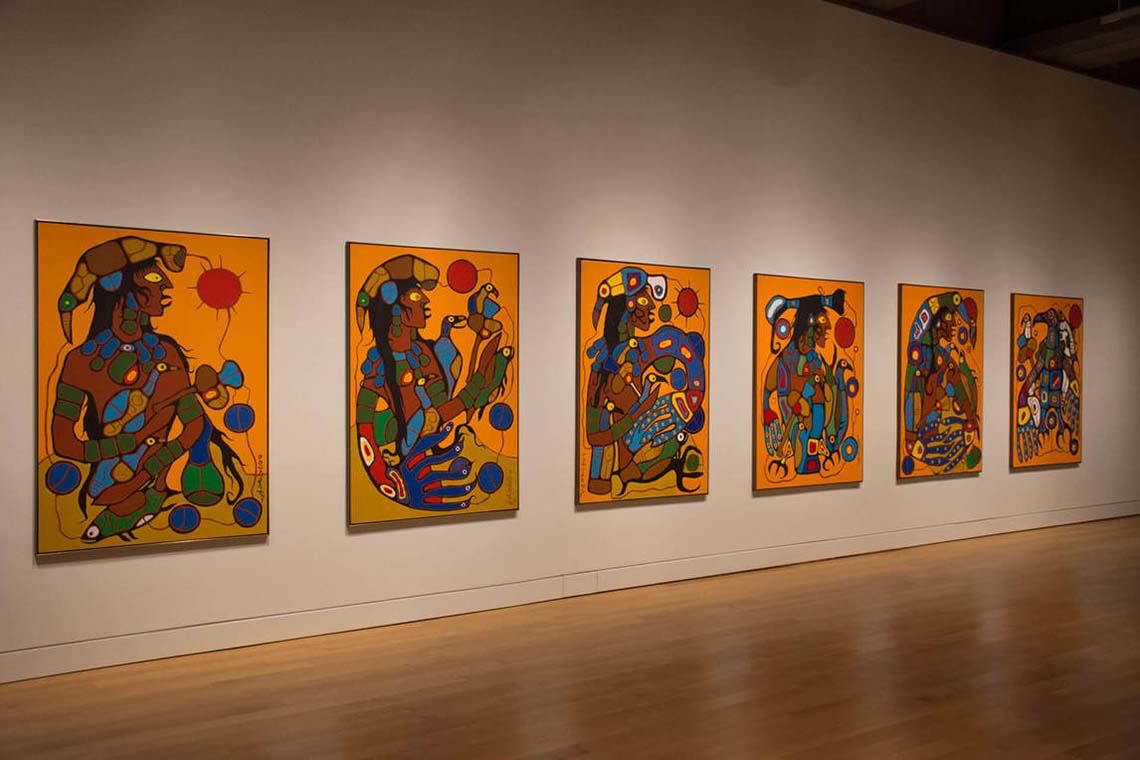
Installation of Man Changing into Thunderbird by Norval Morrisseau at the Art Gallery of Ontario.
Is the following statement true or false? Press “Check Answer” to see how you did.
Appreciation and appropriation
It is important for everyone to learn about different cultures so that we treat people with respect and kindness.
Cultural appreciation occurs when a person wants to learn more about a culture outside of their own. They should educate themselves about the culture and support artists from that culture to show their appreciation.
Cultural appropriation occurs when a person creates new artwork that is based on, or borrows, elements from a culture outside of their own and takes credit for it. It is not appropriate to copy parts of a culture directly in artwork and suggest that it is your own.

It is stealing to copy parts of a culture directly in artwork and take credit for it.
- Why is it important to learn about diverse styles of art from the cultures that developed and create these forms of art?
- What challenges do you think Norval Morrisseau may have faced in creating and exhibiting art for a Canadian audience?
Record your answers using a method of your choice. If possible, share your thoughts with a partner.
Consolidation
Putting it all together

Appreciating art is an important part of understanding the world around us. Art offers us a window into cultures outside of our own. Art also acts as a mirror in which we can reflect on our own emotions and experiences.
Art reviews are one formal way of assessing art. A reviewer thinks critically about an artwork and how to appreciate the culture that it comes from.
Reviewing Woodland Art
Norval Morrisseau wanted his work to be explored by all learners of future generations. The knowledge he shared through his artwork is sacred and powerful. His paintings tell stories and share understandings explored within his own community, and it is a gift he has provided to learners of all ages.
Using what you have learned about Woodland Art, review the following painting. You may do this by completing the Reviewing Art: Norval Morrisseau activity in your notebook or by using the following fillable and printable document. If you would like, you can use speech-to-text or audio recording tools to record your thoughts.
| Record answers to the following questions. | |
|---|---|
| 1) Description | What objects and subjects are represented in this painting? What is their relationship to each other? |
| 2) Elements of design |
How are the elements of design used? Which element stands out most to you? Consider your knowledge of line, shape, colour, value, form, texture, and space. |
| 3) Principles of design |
How are the principles of design used? Which principle stands out most to you? Consider your knowledge of balance, contrast, emphasis, harmony, movement, and proportion. |
| 4) Interpretation |
How does this image make you feel? What does it make you think about? Consider if you make an image-to-self, image-to-image, or image-to-world connection with the image. |
Press the ‘Activity’ button to access Reviewing Art: Norval Morrisseau.

Observations of the Astral World by Norval Morrisseau, 1994
A painting of two groups of people separated by an upside-down tree placed in the centre of a cool-hued blue background. There is a contrast between warm and cool colours which are all pure hues with no change in value. Shapes are outlined with thick, dark lines, and the left side and right side of the image have a symmetrical composition.
The people on the left side of the painting are wearing everyday clothes, such as overalls, and is made up of three adults and one child. They are surrounded by trees and flowers, and some of the leaves of the trees are actually cool-hued purple birds. The bodies of the birds and the leaves are all split in half by lines across their centre. This group of people is encapsulated by a large, organic, warm-hued orange shape, except for the child, who has stepped outside of the shape toward the upside-down tree.
Above the people on the left is a warm-hued yellow circle that a group of fish is coming out of. The group of fish are made of diverse hues and extend from the circle across the right side of image. The fish have a variety of curving lines and organic shapes decorating the inside of their bodies. The people on the right side of the painting are wearing ceremonial clothes, such as headdresses, and is made up of two adults and one child. There is also a bear with a fish for a torso that has a variety of curving lines and organic shapes decorating the inside of its body. This group of people is encapsulated by a large organic shape, except for the adult at the front of the group, who is reaching out and touching the upside-down tree. This adult is wearing a large headdress shaped like a bird and one of their arms is a wing.
All of the people are looking up at the fish coming out of the circle and extending across the right side of the image. These fish disappear into the large organic shape encapsulating the group of people wearing ceremonial clothes on the right side of the painting. This shape is mostly a cool-hued green, but there is a warm-hued yellow portion on its upper-right side that the fish disappear into.
Pause and Reflect
Time to reflect
When you are finished your art review, reflect on the following questions:
- How did learning about Indigenous art forms help you to understand the message of this painting?
- What did you not fully understand about this painting and want to learn more about?
- Why do you think it is important to share Morrisseau’s artwork with future generations?
- How do you think non-Indigenous people can support Indigenous artists in a respectful way that shows appreciation for their cultures?
Record your answers using a method of your choice.
Portfolio
Track your progress
If you have an art portfolio, put your art review in there so that you can track your progress over time.
Share your art review with a partner, if possible.
Reflection
As you read through these descriptions, which sentence best describes how you are feeling about your understanding of this learning activity? Press the button that is beside this sentence.
I feel…
Now, record your ideas using a voice recorder, speech-to-text, or writing tool.
